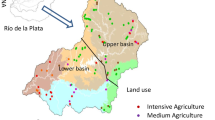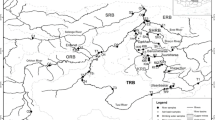Abstract
The aquatic systems responsible for water supply in the Brazilian Federal District (FD) have been threatened by anthropogenic pressures, especially considering the expressive demographic increase in the region during the last decades. The purposes of this research were: (a) to assess the water quality in streams located in the FD by monitoring physical–chemical variables; (b) to define baselines for these variables among different ecological status categories. The 14 investigated streams were sampled between 2006 and 2009, in the dry (August–September, 2006, 2008, 2009) and rainy (March–April, 2008, 2009) seasons. All sampling sites were classified in four categories (“very impacted”, “impacted”, “in transition” and “natural”) using an adaptation of a rapid habitat assessment protocol. Differences in water quality among sites were generally well predicted in the four ecological status categories defined by the protocol, which showed a gradient in nutrient concentrations from reference sites classified as “natural” (medians: electrical conductivity = 7.3 μS cm−1; nitrate = 0.040 mg L−1; ammonium = 0.039 mg L−1; soluble reactive phosphorus (SRP) = <0.001 mg L−1; total phosphorus (TP) = 0.006 mg L−1; ) to those classified as “very impacted” (medians: electrical conductivity = 87.7 μS cm−1; nitrate = 0.247 mg L−1; ammonium = 0.219 mg L−1; SRP = 0.010 mg L−1; TP = 0.035 mg L−1). Point sources inputs were the main factor for water quality deterioration. The nutrient baselines reported were relatively low when compared to data collected from reference areas in Brazil (e.g., São Paulo State) or temperate regions, especially for TP.


Similar content being viewed by others
References
Alencar, D. B. S., Silva, C. L., & Oliveira, C. A. S. (2006). Influência da precipitação no escoamento superficial de uma microbacia hidrográfica do Distrito Federal. Engenharia Agrícola, 26(1), 103–112 (in Portuguese).
Alves, R. I. S., Cardoso, O. O., Tonani, K. A., Julião, F. C., Trevilato, T. M. B., & Segura-Muñoz, S. I. (2013). Water quality of the Ribeirão Preto Stream, a watercourse under anthropogenic influence in the southeast of Brazil. Environmental Monitoring and Assessment, 185, 1151–1161.
APHA. (2005). Standard Methods for the Examination of water and wastewater (21st ed.). Washington, DC: American Public Health Association.
ANA. Water National Agency. (2012). Available at http://www.ana.gov.br. Accessed 19 Jan 2012 (in Portuguese).
Barbour, M.T., Gerritsen, J., Snyder, B.D., Stribling, J.B. (1999). Rapid bioassessment protocols for use in streams and wadeable rivers: periphyton, benthic macroinvertebrates and fish, 2nd ed. EPA 841-B-99-002. Washington, DC: U.S. Environmental Protection Agency; Office of Water.
Biggs, T. W., Dune, T., & Martinelli, L. A. (2004). Natural controls and human impacts on stream nutrient concentrations in a deforested region of the Brazilian Amazon basin. Biogeochemistry, 68, 227–257.
Bispo, F. H. A., Silva, A. C., & Torrado, P. V. (2011). Highlands of the upper Jequitinhonha Valley. Brazil. I. Characterization and classification. Revista Brasileira de Ciência do Solo, 35, 1069–1080.
Brasil (2005). Resolution no. 357, March 17th 2005. Brazilian Council for the Environment (CONAMA). www.mma.gov.br/port/conama/res/res05/res35705.pdf. Accessed 30 June 2013 (in Portuguese).
Bustamante, M. M. C., Nardoto, G. B., Pinto, A. S., Resende, J. C. F., Takahashi, F. S. C., & Vieira, L. C. G. (2012). Potential impacts of climate change on biogeochemical functioning of Cerrado ecosystems. Brazilian Journal of Biology, 72, 655–671.
CAESB. Environmental Sanitation Company of the Federal District. (2011). http://www.caesb.df.gov.br. Accessed 15 Dec 2011 (in Portuguese).
Carmo, M. S., Boaventura, G. R., & Oliveira, E. C. (2005). Geoquímica das águas da Bacia Hidrográfica do Rio Descoberto, Brasília/DF – Brasil. Química Nova, 28(4), 565–574 (in Portuguese).
Carneiro, P. J. R., Maldaner, V. I., Alves, P. F., Queirós, I. A., Mauriz, T. V., & Pacheco, R. F. (2007). Evolução do uso da água na bacia do rio Preto no Distrito Federal. Revista Espaço & Geografia, 10(2), 325–353 (in Portuguese).
Carpenter, S. R., Caraco, N. F., Correll, D. L., Howarth, R. W., Sharpley, A. N., & Smith, V. H. (1998). Nonpoint pollution of surface waters with phosphorus and nitrogen. Ecological Applications, 8(3), 559–568.
Carvalho, P. R. S. (2005). A expansão urbana na bacia do ribeirão Mestre D’Armas (DF) e a qualidade da água. Revista Estudos Geográficos, 3(1), 71–91 (in Portuguese).
Chaves, H. M. L., & Santos, L. B. (2009). Ocupação do solo, fragmentação da paisagem e qualidade da água em uma pequena bacia hidrográfica. Revista Brasileira de Engenharia Agrícola e Ambiental, 13, 922–930 (in Portuguese).
Cunha, D. G. F., Dodds, W. K., & Calijuri, M. C. (2011). Defining nutrient and biochemical oxygen demand baselines for tropical rivers and streams in São Paulo State (Brazil): a comparison between reference and impacted sites. Environmental Management, 48, 945–956.
Dodds, W. K. (2006). Eutrophication and trophic state in rivers and streams. Limnology and Oceanography, 51, 671–680.
Dodds, W. K., Jones, J. R., & Welch, E. B. (1998). Suggested classification of stream trophic state: distributions of temperate stream types by chlorophyll, total nitrogen, and phosphorus. Water Research, 32, 1455–1462.
Dodds, W. K., Bouska, W. W., Eitzmann, J. L., Pilger, T. J., Pitts, K. L., Riley, A. J., Schloesser, J. T., & Thornbrugh, D. J. (2009). Eutrophication of U.S. freshwaters: analysis of potential economic damages. Environmental Science and Technology, 43(1), 12–19.
Dodds, W. K., & Oakes, R. M. (2004). A technique for establishing reference nutrient concentrations across watersheds affected by humans. Limnology and Oceanography: Methods, 2, 333–341.
Dodds, W. K., & Oakes, R. M. (2008). Headwater influences on downstream water quality. Environmental Management, 41, 367–377.
Dodkins, I., Rippey, B., Harrington, T. J., Bradley, C., Chathain, B. N., Kelly-Quinn, M., McGarrigle, M., Hodge, S., & Trigg, D. (2005). Developing an optimal river typology for biological elements within the Water Framework Directive. Water Research, 39, 3479–3486.
Gücker, B., Boëchat, I. G., & Giani, A. (2009). Impacts of agricultural land use on ecosystem structure and whole-stream metabolism of tropical Cerrado streams. Freshwater Biology, 54, 2069–2085.
Hawkins, C. P., Olson, J. R., & Hill, R. A. (2010). The reference condition: predicting benchmarks for ecological and water-quality assessments. Journal of the North American Benthological Society, 29(1), 312–343.
Hilton, J., O’Hare, M., Bowes, M. J., & Jones, J. I. (2006). How green is my river? A new paradigm of eutrophication in rivers. The Science of the Total Environment, 365, 66–83.
IBGE. Brazilian Institute of Geography and Statistics. http://www.ibge.gov.br/home. Accessed 2 July 2012 (in Portuguese).
Lampert, W., & Sommer, U. (1997). Limnoecology: the ecology of lakes and streams. Oxford: Oxford University Press.
Lock, K., Asenovab, M., & Goethals, P. L. M. (2011). Benthic macroinvertebrates as indicators of the water quality in Bulgaria: a case-study in the Iskar river basin. Limnologica, 41, 334–338.
Lorenz, A. W., & Feld, C. K. (2013). Upstream river morphology and riparian land use overrule local restoration effects on ecological status assessment. Hydrobiologia, 704(1), 489–501.
Martinelli, L. A., Coletta, L. D., Ravagnani, E. C., Camargo, P. B., Ometto, J. P. H. B., Filoso, S., & Victoria, R. L. (2010). Dissolved nitrogen in rivers: comparing pristine and impacted regions of Brazil. Brazilian Journal of Biology, 70(3), 709–722.
Morgan, R. P., II, Kline, K. M., & Churchill, J. B. (2013). Estimating reference nutrient criteria for Maryland ecoregions. Environmental Monitoring and Assessment, 185, 2123–2137.
Muniz, D. H. F., Moraes, A. S., Freire, I. S., Cruz, C. J. D., Lima, J. E. F. W., & Oliveira-Filho, E. C. (2011). Evaluation of water quality parameters for monitoring natural, urban, and agricultural areas in the Brazilian Cerrado. Acta Limnologica Brasiliensia, 23(3), 307–317.
Newall, P., & Tiller, D. (2002). Derivation of nutrient guidelines for streams in Victoria, Australia. Environmental Monitoring and Assessment, 74, 85–103.
Padovesi-Fonseca, C., Corrêa, A. C. G., Leite, G. F. M., Jovelli, J. C., Costa, L. S., & Pereira, S. T. (2010). Diagnóstico da sub-bacia do ribeirão Mestre D’Armas por meio de dois métodos de avaliação ambiental rápida, Distrito Federal, Brasil Central. Ambi-Água, 5(1), 43–56 (in Portuguese).
Padovesi-Fonseca, C., & Martins-Silva, M. J. (2012). Biologic integrity analysis as protection tool of Cerrado’s pristine areas. In C. Bilibio, O. Hensel, J.F. Selbach (Orgs.), Sustainable water management in tropics and subtropics and case studies in Brazil, v. 3 (pp 685–721). Jaguarão: UNIPAMPA/UNIKASSELL/PGCULT/UFMA.
Pardo, I., Gómez-Rodríguez, C., Wasson, J.-G., Owen, R., van de Bund, W., Kelly, M., Bennett, C., Birk, S., Buffagni, A., Erba, S., Mengin, N., Murray-Bligh, J., & Ofenböeck, G. (2012). The European reference condition concept: a scientific and technical approach to identify minimally-impacted river ecosystems. The Science of the Total Environment, 420, 33–42.
Parron, L. M., Bustamante, M. M. C., & Markewitz, D. (2011). Fluxes of nitrogen and phosphorus in a gallery forest in the Cerrado of central Brazil. Biogeochemistry, 105, 89–104.
Pretty, J. N., Mason, C. F., Nedwell, D. B., Hine, R. E., Leaf, S., & Dils, R. (2003). Environmental costs of freshwater eutrophication in England and Wales. Environmental Science and Technology, 37(2), 201–208.
Reatto, A., & Martins, E. S. (2005). Classes de solo em relação aos controles da paisagem no bioma Cerrado. In A. Scariot, J.C. Sousa-Silva, J.M. Felfili (Orgs.), Cerrado: Ecologia, Biodiversidade e Conservação (pp 49–59). Brasília: Ministério do Meio Ambiente (in Portuguese).
da Silva, F. A. M., Assad, E. D., & Evangelista, B. A. (2008). Caracterização climática do bioma Cerrado. In S. M. Sano, S. M. P. Almeida, & J. F. Ribeiro (Eds.), Cerrado: Ecologia e Flora (pp. 69–87). Brasília: Embrapa Informação Tecnológica (in Portuguese).
Silva, J. S. O., Bustamante, M. M. C., Markewitz, D., Krusche, A. V., & Ferreira, L. G. (2011). Effects of land cover on chemical characteristics of streams in the Cerrado region of Brazil. Biogeochemistry, 105, 75–88.
Silva, G. B. S., & Steinke, V. A. (2009). Alterações na paisagem e seus impactos diretos nas áreas de preservação permanentes das nascentes da bacia hidrográfica do Ribeirão Taboca (DF): uma análise espaço-temporal1964-2004. Caminhos de Geografia, 10(32), 87–99 (in Portuguese).
Silva, W. J., Felisberto, S. A., Padovesi-Fonseca, C., & Souza, M. G. M. (2010). Serial discontinuity along the Descoberto River Basin, Central Brazil. Acta Limnologica Brasiliensia, 22(3), 344–355.
Smith, R. A., Alexander, R. B., & Schwarz, G. E. (2003). Natural background concentrations of nutrients in streams and rivers of the conterminous United States. Environmental Science and Technology, 37, 2039–3047.
Thomas, S. M., Neill, C., Deegan, L. A., Krusche, A. V., Ballester, V. M., & Victoria, R. L. (2004). Influences of land use and stream size on particulate and dissolved materials in a small Amazonian stream network. Biogeochemistry, 68, 135–151.
Vendrame, P. R. S., Brito, O. R., Guimarães, M. F., Martins, E. S., & Becquer, T. (2010). Fertility and acidity status of latossolos (oxisols) under pasture in the Brazilian Cerrado. Anais da Academia Brasileira de Ciências, 82(4), 1085–1094.
Wantzen, K.M. (2003). Cerrado streams—characteristics of a threatened freshwater ecosystem type on the Tertiary Shields of Central South America. Amazoniana, XVII(3/4), 481–502.
Zeilhofer, P., Lima, E. B. N. R., & Lima, G. A. R. (2006). Spatial patterns of water quality in the Cuiabá river basin, central Brazil. Environmental Monitoring and Assessment, 123, 41–62.
Acknowledgments
This work was supported by Fundo Nacional do Meio Ambiente (FNMA) (Process 02000.005571/2005-89). We thank the Catholic University of Brasília (UCB) for the scholarships granted to undergraduate students and for the chemical analyses (especially to the environmental engineers Rafael Morgado and Rodrigo Zolini); the Department of Ecology of the University of Brasília (UnB) for the transport during field work, especially the driver Mr. Mardônio Timo; the administration and staff of Águas Emendadas Ecological Station for their support within this conservation unit. We are also grateful to colleagues involved in field and laboratory work, specially the undergraduate students.
Author information
Authors and Affiliations
Corresponding author
Rights and permissions
About this article
Cite this article
Fonseca, B.M., de Mendonça-Galvão, L., Padovesi-Fonseca, C. et al. Nutrient baselines of Cerrado low-order streams: comparing natural and impacted sites in Central Brazil. Environ Monit Assess 186, 19–33 (2014). https://doi.org/10.1007/s10661-013-3351-8
Received:
Accepted:
Published:
Issue Date:
DOI: https://doi.org/10.1007/s10661-013-3351-8




